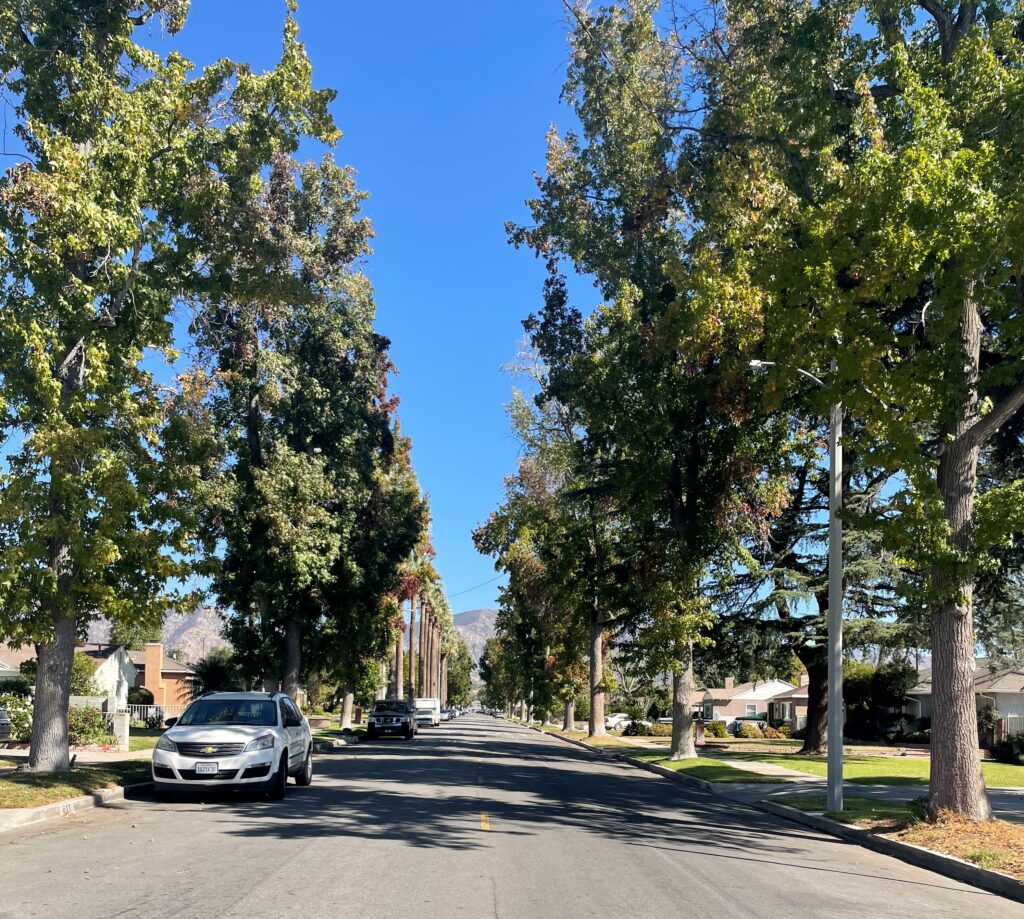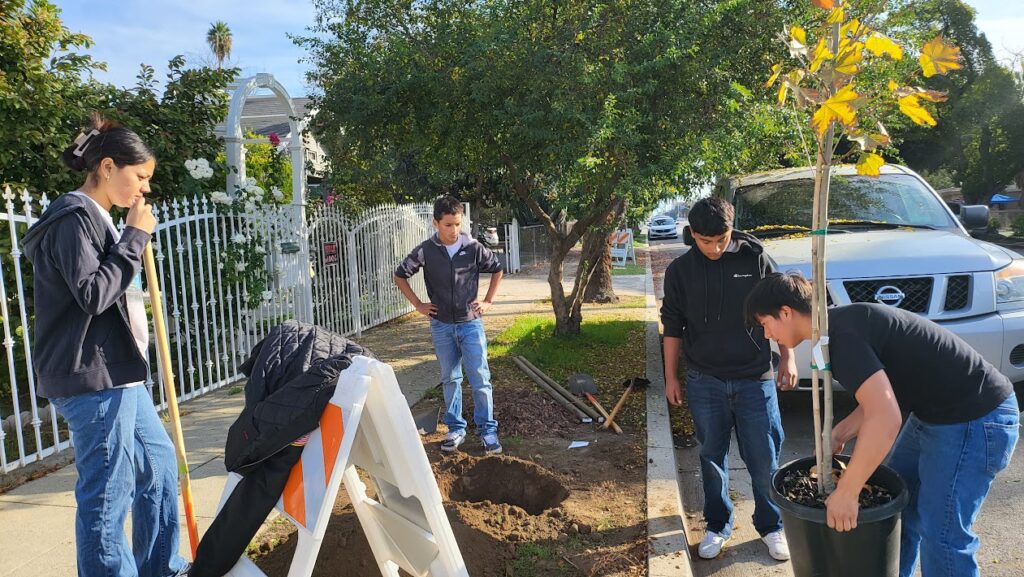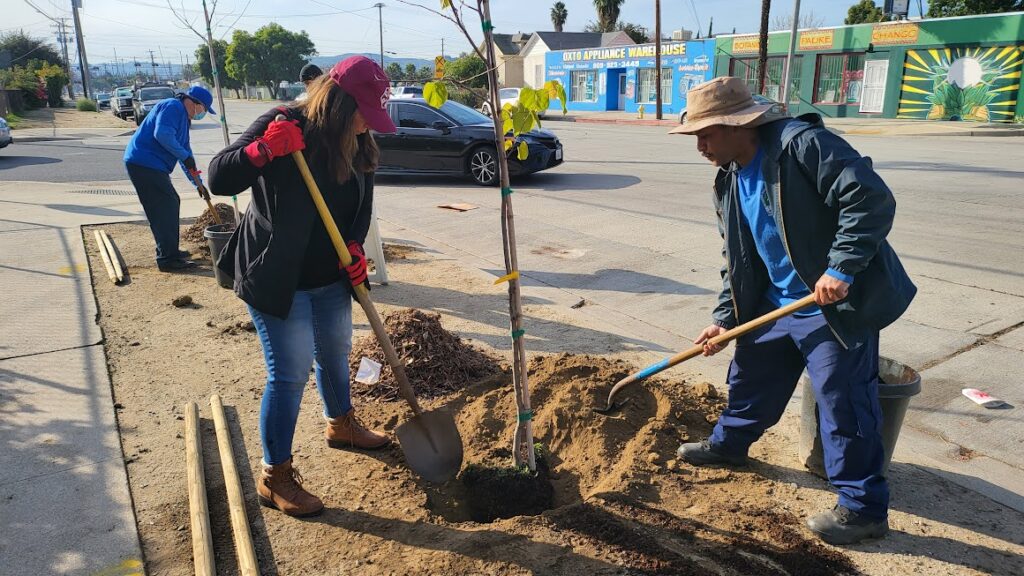“Why Don’t you Want a Tree?” – Attitudes Toward Tree Planting in Urban Neighborhoods
Sahar Fazelvalipour | February 7, 2023

“What are you doing? Getting ready to do some digging?” the man asked as he hurried down the sidewalk in front of his house. He was chasing down two volunteers from Clean & Green Pomona, a community-based nonprofit that plants trees in Pomona, California. The two were armed with clipboards, camera phones, and marking paint.
“The city is going to be planting trees along the street, and we are marking the locations,” one of the volunteers responded.
“Oh No!” the man cried, whose name was Jose. “Not more trees. The city doesn’t take care of what they’ve planted already, and my wife and I are constantly harassed by bees that swarm the trees when we are getting in and out of our cars.”
Clean & Green Pomona has been planting trees in the city since 2017, often in schoolyards and parks, but increasingly along streets in parts of the city that lack substantial tree cover. As part of their effort, they go door-to-door along the streets they plant to share information about the trees, encourage residents to help care for them, and recruit volunteers to help plant. But this crew was out marking locations before the door-to-door outreach had been conducted in this neighborhood.
After much discussion, and an assurance that the trees that were being planted were different than the existing trees that attract bees, the resident expressed some willingness for the work to proceed. Clean & Green Pomona reports that most residents are in favor of tree plantings on their streets – in fact the city had identified this block for planting because some residents had been asking for trees. But there are always people who are concerned and resistant to tree planting efforts, even in neighborhoods that have lacked substantial tree cover, and need more trees to combat the effects of climate change.

The Benefits of Tree Planting
Based on data provided by the National Drought Mitigation Center, the effects of climate change, including drought and increased urban heat have increased substantially over the past 15 years. However, street trees provide many benefits, such as reducing the urban heat island effect, removing carbon dioxide from the atmosphere, and even improving economic health. Many people think street trees are a luxury item for a neighborhood, primarily planted to increase the beauty and attractiveness of the neighborhood. But, according to the EPA, it is beyond debate that suitable vegetation provides shade for building surfaces, streets and sidewalks, reducing the effect of the sun’s radiation and increasing atmospheric moisture. As such, trees are essential in reducing urban heat and energy demand for buildings that benefit from the shade.
Other benefits of urban trees have been documented. Urban tree coverage can create a safer environment, improve businesses, reduce stormwater runoff and flood potential, reduce the need for stormwater infrastructure, improve psychological health and also increase home and business value.
Despite the Benefits, Some People Resist
The interaction between Clean & Green Pomona and a resident is far from unusual. Researchers in Philadelphia, Pennsylvania recently published an article in the journal Urban Forestry and Urban Greening, examining why people often resist tree planting in their neighborhoods. Discussions with local tree planting organizations revealed barriers to participation in their initiatives, so the researchers interviewed community leaders in North Philadelphia to better understand the reasons commonly given for resisting tree planting programs.
Researchers found that the most common concern mentioned by interviewees was fear of costs associated with structural damage from the tree, such as roots damaging sewer lines or sidewalks. Many were also concerned about potential damage a tree could cause if it falls or lost major limbs, and the future cost of tree removal when it becomes a burden, if that falls to the property owner. While cities may be responsible for damage to public property such as sidewalks caused by street trees, homeowners are typically responsible for damage to their own sewer lines, driveways, or homes. As the researchers note, these potential cost concerns may be even more significant in low-income communities.
The authors of the Philadelphia study refer to these effects as “Tree disservices,” and these disservices extend beyond costs to other negative attributes, such as debris, fallen leaves, and even bees as in the case of Pomona. Such disservices have the potential to cause neighborhood disputes as problems spread from one property to the next. As one interviewee described “when leave fall, somebody’s going to clean them up and…when the leaves fall they just don’t fall in your yard, they fall and the wind carries them all up and down your block.” (P. 5)
In communities where many residents do not speak English as their primary language, communication barriers can be a significant challenge. When people cannot receive information about the trees or the planting program in their language, it causes concern and decreases participation. While many organizations develop bi-lingual materials, there are often more than two languages being spoken in a community and small organizations struggle with the time, expertise and expense of producing materials in multiple languages.
Finally, researchers also described barriers associated with mistrust of outside groups that do not give the impression they intend to engage communities over the long-term, and help them with problems that may arise. This is particularly the case when organizational membership does not reflect the demographic of the surrounding neighborhood. As the authors note, organizations led primarily by white leaders often experience “conflict in making decisions for a historically Black or Brown neighborhood community that has encountered rapid displacement among longtime residents.” (P. 6).

A Path Forward
While the Philadelphia study highlights significant barriers, we should never lose sight of the fact that increasing tree canopy cover and green spaces provides essential environmental, economic, Psychological, and physical health benefits. The advantages of tree planting heavily outweigh the disadvantages. So how might organizations overcome some of these barriers?
Clear and persistent communication in languages understood by the community is essential. As the authors of the Philadelphia study point out, counter-messages about the hazards of trees are common in communities. They quote one respondent as saying “when we ask someone if they want a tree, they have a story of someone they know or someone on their block had a tree back in the day on their sidewalk and it got huge and it was dangerous.” (P. 6). There may be little that organizations can do to stop these stories from spreading.” But they may be able to encourage alternative narratives. In the case of Clean & Green Pomona, they were planting in Jose’s neighborhood at the request of some residents. If these residents can be cultivated to share the benefits they see in tree planting with their neighbors. This message may be more likely to be accepted by people in the neighborhood, than expert information shared by outside groups.
It must also be recognized that while people’s concerns with costs may not be based on complete information, they are legitimate and should not be dismissed by tree planting groups. Additional education and sharing accurate information about tree characteristics, including growth rates, spread and maintenance needs may alleviate some of these concerns. But consideration should be given to city maintenance budgets, the age of infrastructure such as sewer lines, and their likelihood of failure. Cities and organizations should consider financial support for maintenance and infrastructure replacement in high priority planting areas, such as low-income communities with very low tree canopy cover and aging infrastructure.

Sahar Fazel is a graduate student in the Master of Landscape Architecture program at California State Polytechnic University, Pomona. She holds a BS in Architectural Engineering focusing on thermal performance and saving energy from Azad University. She also has been an intern at the California Department of Transportation since July 2021 and an Assistant Instructor at the University of California DAVIS. Her passion for a holistic approach to creating environmentally sustainable places where people need to live and helping to shift to a carbon-neutral future led her to extend her Architectural education into Landscape Architecture which will let her focus more on significant landscape issues, including Climate Change. Combining these majors will help her concentrate on green infrastructure with a water-efficient plan, appropriate biodiversity, great climate adaptation, suitable biodiversity, better air quality, and social justice issues. She would love to continue her major, get her Ph.D., do more research on her interest area, and have an academic job and have her firm on a side where she may help herself, her community, and her industry to grow and have a healthier life.